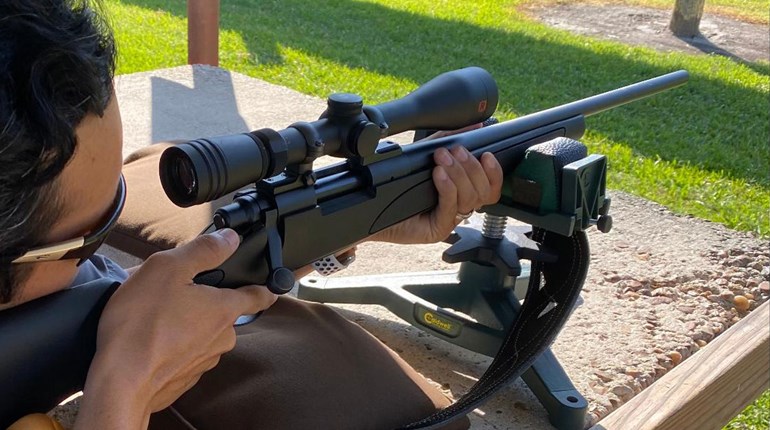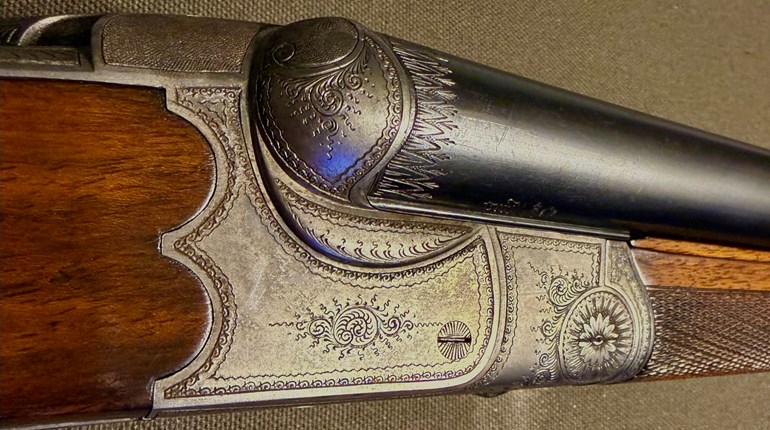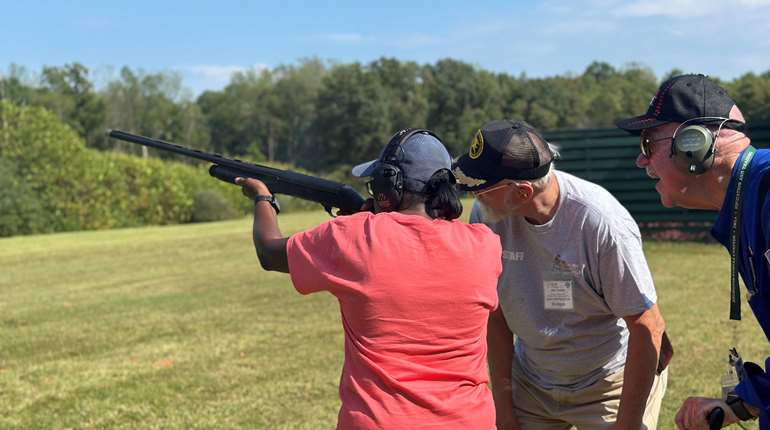
To a beginner shotgun shooter, understanding the different sizes and types of shot can be overwhelming. When it comes to handguns and rifles, the operator needs to know the correct caliber in which his or her firearm is chambered, and then choose from a limited number of cartridge weights and velocities that match the firearm. A shotgun shooter, however, must understand a lot more information for the gauge he or she is shooting.

For example, a shotgunner must know the types of shot pellets and their uses. Shot pellets, offered in both lead and steel, are the most common type of projectile used in shotgun shells. There are five types of shot pellets: soft shot, chilled shot, hard shot, plated shot, and non-toxic shot. A sixth type, buffered shot, has to with what is added to the shot, as opposed to a type of shot.
Soft Shot
Soft shot, often referred to as drop shot, is made up of almost entirely lead. It is very soft and deforms easily—in fact, it does so as it travels down the barrel before exiting the muzzle. Soft shot retains its energy and flattens easily when hitting the target. It is very effective when hunting small game animals and birds. It also has less recoil than other types of shot. Soft shot is preferred by many upland game bird hunters and those who engage in shotgun clay shoot games.
Chilled Shot
Chilled shot is a mixture of lead, and an element called antimony. Some chilled shot contains up to 2 percent of antimony to harden the shot. While antimony is added to soft shot to make it slightly hardened, it still deforms as it travels down the barrel and impacts the target. Chilled shot is preferred when hunting medium-size game birds for deeper penetration. This type of shot is good for birds such as chukar, pheasant, and grouse.

Hard Shot
Hard shot contains a larger percentage of antimony, which decreases pellet deformation. The industry standard for hard shot is 5 percent antimony. This shot is sometimes referred to as “magnum” or “target grade” shot. Another benefit of hard shot is that it keeps a tighter pattern at greater distances. Hard shot is a good choice for small game hunting, or bird hunters that are shooting game at distances greater than 30 yards.

Plated Shot
Plated shot is lead shot that has been plated with copper or another alloy. Plated shot is very hard but still retains deforming properties. This allows this type of shot to be fired from a shotgun with a full choke without damaging the barrel. It also has great penetration when hitting a target. Plated shot is used for larger upland game birds, medium-sized game animals, and predator hunting.
Non-Toxic Shot
Non-toxic shot are pellets that do not contain lead. Collectively, often referred to as “steel” shot, non-toxic shot can be steel, tungsten, tungsten alloy, hevi-shot, or bismuth. Of these, steel shot is the most common. Since steel does not compress, for safety reasons it is important to remember to never shoot steel shot out of a full choke because of the risk of damaging the barrel of your shotgun. Non-toxic shot is now the only legal shot to use for waterfowl hunting in all 50 states. It is now also required in many states and on most federal lands regardless of if other shot is legal in that state.
Buffered Shot
Buffered shot is where pellets, regardless of the type, are mixed with a soft filler substance or small grains of plastic in the hull. This material acts to protect the shot from deformation as it travels down the barrel. It also aids in ease of travel through the choke of the barrel. The main problem with buffer shot is that if the end of the shotshell is not tightly crimped, the buffering agent slips out and leaks everywhere, including the action of the gun.
Shot Size
Understanding the correct shot size is important for several reasons. If you are someone who enjoys the various shotgun games, knowing the correct shot size can help you save money and have more success breaking clay targets. If you are a hunter, the correct shot size can help you make a quick, clean and ethical shot as well as doing the least amount of damage to the edible portions of the game.
It is important to remember that the larger the shot size number, the smaller the shot size. For example, number 8 shot is smaller than number 2 shot. Remember, the smaller the shot size, the more pellets there will be in the shotshell. For example, the number 8 shot can contain up to 769 pellets in a 1 7/8-oz. load, and the number 2 shot can only contain up to 163 pellets in the same 1 7/8-oz. load.

From left, shot sizes, 6, 5 and 4

From left, shot sizes 9, 8 and 7.5.

From left, shot sizes 2, 3, 6 and 8.
Birdshot
Birdshot is on the smaller end of the shot size spectrum. Birdshot can range from “dust” at .04” in diameter to 1 shot that measures .16” in diameter. Usually 9 shot is the smallest shot size somewhat easily found on store shelves. Clay shooting is usually done with 7 ½-shot or 8 shot. Pheasant hunters usually use 6 shot or 5 shot. Duck hunters, especially teal hunters, usually use 4 shot up to 1 shot. Birdshot sizes must be non-toxic if hunting waterfowl.
B-Shot
B-shot size is either B-shot, BB-shot, or BBB-shot. B-shot is .177” in diameter, BB shot is .180” in diameter, and BBB shot is .190” in diameter. B-shot is usually used by “big” duck and goose hunters. B shot sizes must be non-toxic if hunting waterfowl.
T-Shot
T-shot is .20” in diameter. This larger size shot is usually used by goose hunters after large-bodied birds such as Canada and Snow geese. T-shot is also used by sandhill crane and swan hunters because of superior performance at longer ranges, as compared to B-shot sizes. T-shot must be non-toxic if hunting waterfowl.
F-Shot
F-shot is .22” in diameter. F-shot is not common and can be difficult to source. This size is a great shot size for the largest of game birds such as crane and swans. F-shot must be non-toxic if hunting waterfowl.
Buckshot
Buckshot is used for both hunting and for self-defense. Buck shot sizes, from small to large, are Number 4 Buckshot (.24”), Number 3 Buckshot (.25”), Number 2 Buckshot (.27”), Number 1 Buckshot (.30”), 0 Buckshot (.32”), 00 Buckshot, often referred to as “double-ought” (.33”), and 000 Buckshot, often referred to as “triple-ought” (.36”). In a 2 ½-ounce load, the number of pellets in a 2 ½-oz. load, a Number 4 can have up to 52; a Number 3 can have up to 44; a Number 2 can have up to 37; a Number 1 can have up to 24; a 0 can have up to 22; a 00 can have up to 20; a 000 can have up to 15 pellets.

From left, 000 buckshot, 00 buckshot and 0 buckshot.
Slug
Like the buckshot, slugs can be used for both hunting and self-defense. A slug is a single projectile shot from a shotshell. It is similar to a rifle bullet but is much heavier and travels relatively short distances. Though the distance a slug travels is much smaller than a bullet, it is important to remember that slugs can travel up to one mile. Slugs range in weight from 7/8-oz. to the gigantic 2½ oz. The most common is the 1-oz. slug.

A variety of slugs.
It is important that shotgunners know the different types of pellets and match the size to the shooter’s objective. To re-emphasize, knowing this information can save the shooter money. It also allows the hunter to make that quick, clean and ethical shot. There is another more important reason to know the types and sizes of shot. That reason is for safety!
Safety trumps everything! The more educated a shooter is, the safer he or she will be. Understanding the types and sizes of shotshells can prevent accidents. Remember, the smaller the shot size, the more pellets exit the muzzle. The more pellets there are, the higher the potential of hitting an unintended target. Additionally, the heavier the pellet, the further it travels.
The best way of staying safe is using the right type and size of shot!














































